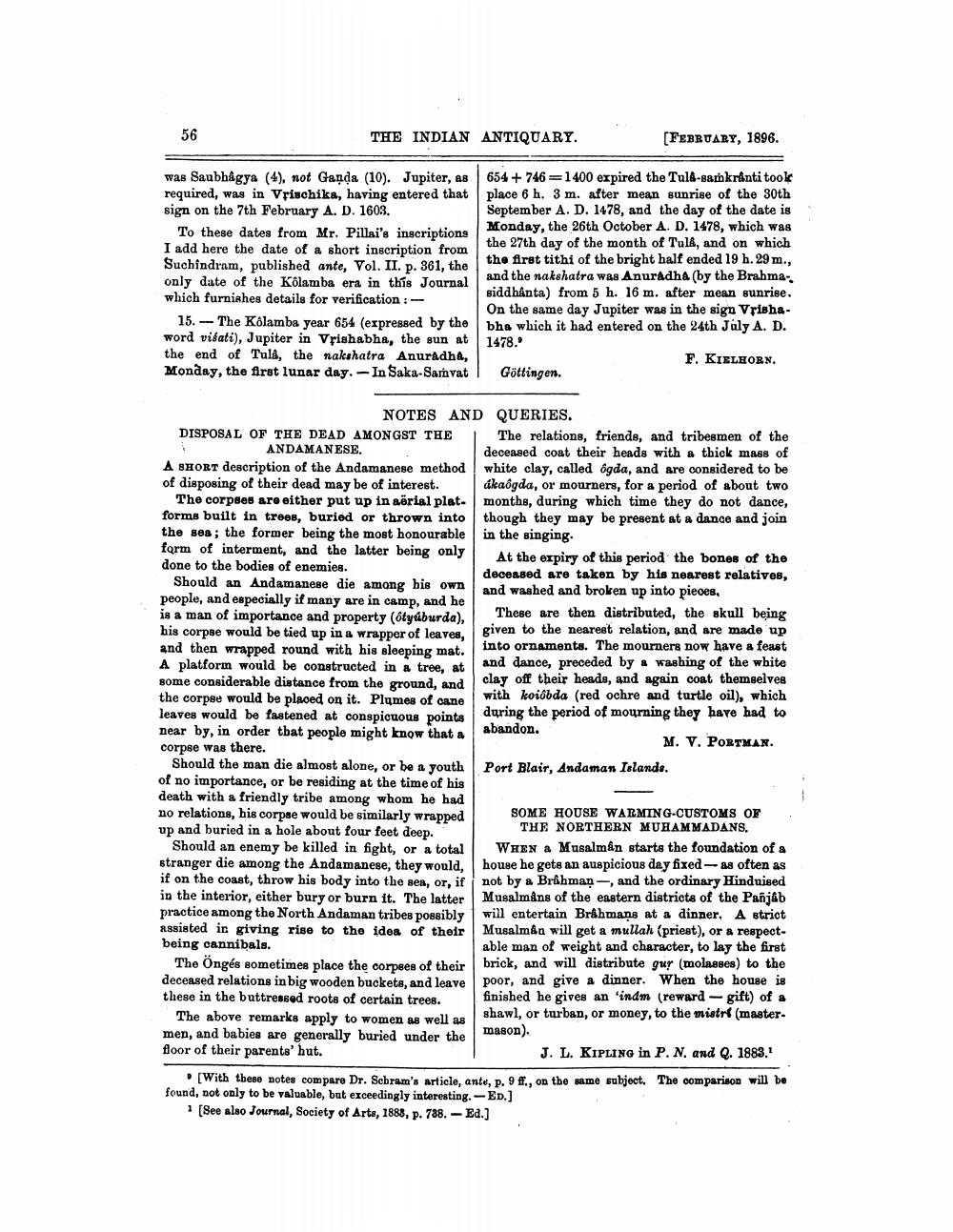________________
56
THE INDIAN ANTIQUARY.
(FEBRUARY, 1896.
was Saubhagya (4), not Ganda (10). Jupiter, as 654 + 746=1400 expired the Tuld-sankranti took required, was in Vrischika, having entered that place 6 h. 3 m. after mean sunrise of the 30th sign on the 7th February A. D. 1603.
September A. D. 1478, and the day of the date is To these dates from Mr. Pillai's inscriptions
Monday, the 26th October A. D. 1478, which was
the 27th day of the month of Tula, and on which I add here the date of a short inscription from Suchindram, published ante, Vol. II. p. 361, the
the first tithi of the bright half ended 19 h. 29 m., only date of the Kolamba era in this Journal
and the nakshatra was Anuradha (by the Brahma.
siddhanta) from 5 h. 16 m. after mean sunrise. which furnishes details for verification :
On the same day Jupiter was in the sign Vrisha15. - The Kalamba year 654 (expressed by the bhs which it had entered on the 24th July A. D. word vifati), Jupiter in Vrishabha, the sun at 1478. the end of Tula, the nakshatra Anuradha,
F. KIELHORN. Monday, the first lunar day. - In Saka-Samvat Göttingen.
NOTES AND QUERIES. DISPOSAL OF THE DEAD AMONGST THE The relations, friends, and tribesmen of the ANDAMANESE.
deceased coat their heads with a thick mass of A SHORT description of the Andamanese method white clay, called ôgda, and are considered to be of disposing of their dead may be of interest. ákaôgda, or mourners, for a period of about two
The corpses are either put up in aërial plat. months, during which time they do not dance, forms built in trees, buried or thrown into though they may be present at a dance and join the sea; the former being the most honourable in the singing. form of interment, and the latter being only
At the expiry of this period the bones of the done to the bodies of enemies.
deceased are taken by his nearest relatives, Should an Andamanese die among his own
and washed and broken up into pieces, people, and especially if many are in camp, and he is a man of importance and property (tyúburda),
These are then distributed, the skull being his corpse would be tied up in a wrapper of leaves,
given to the nearest relation, and are made up and then wrapped round with his sleeping mat.
into ornaments. The mourners now have a feast A platform would be constructed in a tree, at
and dance, preceded by a washing of the white some considerable distance from the ground, and
clay off their heads, and again coat themselves the corpse would be plaoed on it. Plumes of cane
with koiôbda (red ochre and turtle oil), which leaves would be fastened at conspicuous points
during the period of mourning they have had to near by, in order that people might know that a
abandon.
M. V. PORTMAN. corpse was there.
Should the man die almost alone, or be a youth Port Blair, Andaman Islands. of no importance, or be residing at the time of his death with a friendly tribe among whom he had no relations, his corpse would be similarly wrapped
SOME HOUSE WARMING-CUSTOMS OF . up and buried in a hole about four feet deep.
THE NORTHERN MUHAMMADANS. Should an enemy be killed in fight, or a total WHEN a Musalman starts the foundation of a stranger die among the Andamanese, they would, house he gets an auspicious day fixed -- as often as if on the coast, throw his body into the sea, or, if not by a Brahman-, and the ordinary Hinduised in the interior, either bury or burn it. The latter Musalmans of the eastern districts of the Panjab practice among the North Andaman tribes possibly will entertain Brahmans at a dinner, A strict assisted in giving rise to the idea of their
Musalman will get a mullah (priest), or a respectbeing cannibals.
able man of weight and character, to lay the first The Öngés sometimes place the corpses of their
brick, and will distribute gur (molasses) to the deceased relations in big wooden buckets, and leave
poor, and give a dinner. When the house is these in the battressed roots of certain trees.
finished he gives an 'indm (reward-gift) of a The above remarks apply to women as well as
shawl, or turban, or money, to the mistri (master. men, and babies are generally buried under the
mason). floor of their parents' hut.
J. L. KIPLING in P. N. and Q. 1883.
[With these notes compare Dr. Sebram's article, ante, p. 9 ff., on the same subject. The comparison will be found, not only to be valuable, but exceedingly interesting. ED.]
[See also Journal, Society of Arts, 1888, p. 788. -Ed.]




